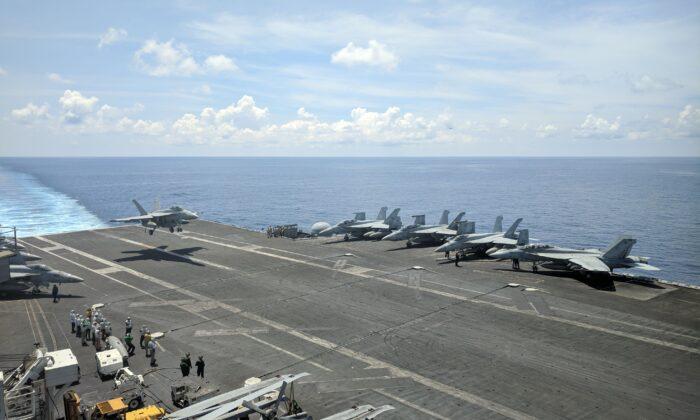WASHINGTON—Since China began turning Pacific reefs and atolls into militarized islands, countries around the world have struggled with how to respond.
Complicating the matter is what is known as the Hague verdict.
That intractability on China’s part, combined with the reality of militarized islands, a massive military buildup since Xi Jinping took office in 2013, and the scope and impact of investments under the “One Belt, One Road” (OBOR) initiative—which include port facilities from Asia to Africa—were the topics of a panel discussion on Dec. 5 at George Washington University’s Elliott School of International Relations in Washington.
Focusing on the Chinese challenge from the perspectives of the United States, the European Union, and India, a single point of convergence emerged among panelists. All three of the entities have been hamstrung by domestic factors that have shaped and limited their responses to China’s aggressive island-building and military installations in the South China Sea.
In addition, panelists asserted that the United States, the EU, and India aren’t prepared to challenge China on its claims of island territories that are hotly disputed by countries such as Japan, Vietnam, and the Philippines.
A Divided EU Responds
“The EU has a general policy that is committed to protect freedom of navigation, the Law of the Sea, and arbitration,” one of the panelists, Liselotte Odgaard of the Hudson Institute, said.“Echoes of the EU perspective” are found in the Indian approach to keeping the South China Sea open to international freedom of navigation, said another panelist, Deepa Ollapally of the Elliott School’s Sigur Center for Asian Studies.
“We are both liberal, and we are both allies of the United States,” she said.
Europe’s 28 member countries—27, should the United Kingdom exit—have “more coherence than ever” within the structure of the EU, Odgaard says. Beyond that, however, the EU as a whole “hasn’t been able to agree on much” with respect to countering China in waters it claims exclusively for itself.
The concerns of some individual member states are a barrier to a unified EU response to China’s incursions into the international waters of the South China Sea.
“Greece and Hungary want to attract investment from China,” Odgaard said.
Additionally, “Croatia and Slovenia have their own maritime dispute,” which goes back to the establishment of each nation out of the breakup of Yugoslavia in 1991. Fearful of creating a precedent that could nullify their own respective claims to disputed waters, the Balkan states have pulled back from challenging China on its refusal to accept and abide by the Hague verdict.
Thus, in what can be seen as a weakness of the European Union’s ability to act cohesively in the face of Chinese aggression in the South China Sea, the EU relies upon a smaller group of its members to pursue freedom of navigation.
Odgaard said that groups of countries with like-minded approaches to a policy “can go very far and not take into account outlier nations that don’t agree” with a particular policy.
Therefore, France, the UK, Denmark, Germany, and Italy have confronted attempted Chinese hegemony in the South China Sea by contributing to Freedom of Navigation Operations (FONOPs), while other European nations have stayed home.
India Defends Indian Ocean
While a partial European reply to China’s hopes for hegemony in the South China Sea is largely a matter of political principle, India’s growing voice on the issue is as much practical as it is principled.India is a major power and has its own interests in the region, Ollapally said. Echoing the EU policy position, she stated that “India doesn’t have a stake in the territorial dispute” among China and its neighbors, and so has kept out of that issue.
India’s interest in the South China Sea lies in its proximity to the Malacca Strait, which divides the South China Sea from the Indian Ocean.
Two issues are key for India. More than half of all Indian trade goes through the South China Sea region, so freedom of navigation is vital to Indian economic and trading interests. And at a more strategic level, India’s perspective has been changed by Chinese activism in the Indian Ocean.
Ironically, the Hague verdict that made some nations shy of challenging China was pivotal in provoking India to act decisively.
China’s refusal to accept the Hague verdict “suggested to India that the diplomatic route was not going to be the norm” in dealing with Chinese maritime claims and activity.
India only addressed the issue formally five years ago, when, in a 2014 joint statement with then-U.S. President Barack Obama, India formally stated its commitment to ensuring freedom of navigation in the South China Sea.
Two years later, when China’s defiance of international law emerged through its denial of the validity of the 2016 Hague verdict, “a huge change” was created in the Indian perspective, Ollapally said.
If China is going to challenge maritime freedom and international law in the South China Sea, “they’re going to do the same in the Indian Ocean,” Ollapally said. “Ultimately, India’s concern is the Indian Ocean. China’s main interest in the Indian Ocean area is energy. More than 80 percent of China’s oil comes from the Middle East through Indian waters.”
The Chinese are “pushing India out of neighboring states through money and influence, as China’s ambitions are growing.”
Therefore, although earlier held back by India’s reluctance to openly challenge China’s maritime activities, India is now acting.
“If China would gain control over the South China Sea, then it could leapfrog into the Indian Ocean. That would give China a decided advantage over India,” Ollapally said.
Navigation
What the United States cares about is navigation, according to panelist Harrison Pretat of the Center for Strategic & International Studies (CSIS).As the United States and its partners have attempted to maintain freedom of navigation in the South China Sea, it’s met with a multitude of Chinese measures designed to deter those efforts, Pretat said.
As has been widely reported, islands and new man-made features have been militarized with missiles, fighters, and bombers. But the importance now isn’t so much what is happening on the islands, as what is happening in the waters around them, he said.
Satellite photos and other imagery illustrate the “maritime militia” that China has developed in the South China Sea. While fishing boats are seen bobbing on the water, suspiciously, those boats don’t place fishing nets in the sea around them.
Those vessels can now “stay at the islands full-time,” according to Pretat. Chinese Coast Guard activity is heating up as well.
As with the EU and Indian perspectives, “the United States doesn’t really care about the territorial dispute,” unless those territories were “gained by force,” he said.
Much more important to the Chinese regime is their “goal to push claimants out of waters” that those nations are entitled to under international law, he said. But with freedom of navigation as the “most visible U.S. response” to countering that Chinese goal, most of the effort comes from the Department of Defense, which has limited tools at its disposal.
Efforts on the part of all parties continue, however.
In April, India and the United States conducted an anti-submarine warfare drill in the Indian Ocean.
“There is only one target this can be for, and that’s China, no matter what one can say,” Ollapally said.
She added, “We will see much more Indian activism and greater partnership with the EU, especially France, and the United States.”




